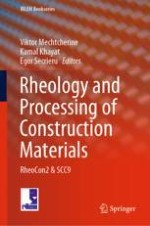2020 | OriginalPaper | Buchkapitel
Particle Interactions in Silica Systems in Presence of Superplasticizer
verfasst von : Simon Becker, Zichen Lu, Sarah Leinitz, Wolfram Schmidt, Dietmar Stephan, Regine von Klitzing
Erschienen in: Rheology and Processing of Construction Materials
Aktivieren Sie unsere intelligente Suche, um passende Fachinhalte oder Patente zu finden.
Wählen Sie Textabschnitte aus um mit Künstlicher Intelligenz passenden Patente zu finden. powered by
Markieren Sie Textabschnitte, um KI-gestützt weitere passende Inhalte zu finden. powered by
